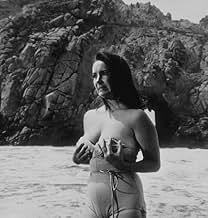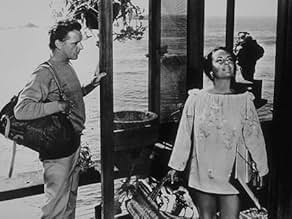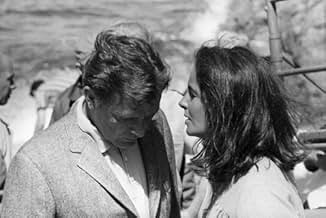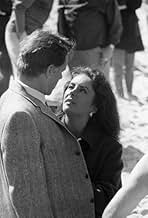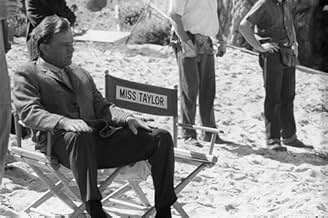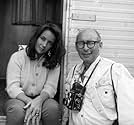Danny Reynolds vit seul avec sa mère. Après qu'il ait tué un chevreuil, les autorités l'envoient dans un internat. Commence alors une idylle scandaleuse entre sa mère et le prêtre chargé de ... Tout lireDanny Reynolds vit seul avec sa mère. Après qu'il ait tué un chevreuil, les autorités l'envoient dans un internat. Commence alors une idylle scandaleuse entre sa mère et le prêtre chargé de l'éducation du jeune garçon..Danny Reynolds vit seul avec sa mère. Après qu'il ait tué un chevreuil, les autorités l'envoient dans un internat. Commence alors une idylle scandaleuse entre sa mère et le prêtre chargé de l'éducation du jeune garçon..
- Réalisation
- Scénario
- Casting principal
- Récompensé par 1 Oscar
- 3 victoires et 3 nominations au total
- Phil Sutcliff
- (as Doug Henderson)
- Trooper
- (non crédité)
- Trustee's Wife
- (non crédité)
- Celebrant #9
- (non crédité)
- Trooper
- (non crédité)
- Celebrant #7
- (non crédité)
- Walter Robinson
- (non crédité)
- Trustee
- (non crédité)
Avis à la une
Set in the mid-sixties, when sexual morays were loosening but we were still in the grip of a churchy moralism, this had to be a controversial film, and I vaguely recall that it was. You can visit the locations used in the movie because some are easily recognizable, such as the store/club/restaurant in Big Sur known as "Nepenthe." And of course, there are the famous stone bridges on Highway One spanning two or three of the rugged chasms. Coursing through the movie, especially during the several seascapes, is the theme "The Shadow of Your Smile." It's a nice movie, if not a great one, and worth seeing more than once.
This is definitely more compelling due to Taylor and Burton's real-life love affair. It's a quiet melodrama. There are some intensity usually between the couple. Otherwise, it's a low simmering romance that could push some buttons due to Hewitt as a religious figure.
"The Sandpiper" begins with a VERY free-spirited mother (Elizabeth Taylor) being hauled into family court because her young son has had another brush with the law. The problems are not serious but the judge is shocked that Taylor is so unrepentant in the way she raises the kid. She's an atheist, is extremely permissive and home schools the boy with her own blend of unusual teaching. Nowadays or even in the late 60s, this sort of child raising wouldn't have gotten much notice (particularly in California)--but here in 1965 it's a bit scandalous--especially since Taylor's character never married nor does she care about legitimizing the boy. Because of this and the child's actions, he is sent to live at a nearby residential school run by the church. Taylor thinks that the Episcopal priest running the place (Richard Burton) is shocked by all this and immediately dislikes him, but he seems rather patient and caring. However, through the course of the film, the two begin to see each other more and more and it's apparent that soon the two will be hitting the sheets together--even though he's married (to a woman, not just God). What's to come of these two? See the film if you'd like.
Apart from the great location shooting, the film is a mixed bag. Some would clearly be offended by its irreverent plot, others bored (as it's VERY talky at times and the dialog becomes awful at about 80 minutes into the film) and others would love it. Those who like really salacious soaps of the era (such as "Peyton Place" and the like) will probably adore the film--as it is filled with fiery content (not just the affair but an attempted rape) and a good looking couple (well, at least Liz). And, in many ways, these same folks often felt like they were peering into the real life relationship between this couple. As for me, I loved the scenery and laughed at the love story. It seemed contrived and you wondered just how any priest could be that stupid. Plus, the dialog between Liz and Dick on the beach was pretty laughable as was the fight at the 106 minute mark and Dick's sermon towards the end. I see the film as a guilty pleasure you see once...and only once. Then, afterwords, to make penance for this, you should watch a really GOOD film!
By the way, despite the name, San Simeon School is supposed to be in nearby Monterey (just north of Big Sur) and has no relation to the Hearst mansion (San Simeon) a couple hours south. Also, I was impressed by a supporting role by James Edwards. For a black actor, it was a great role--a non-black and non-stereotypical role. For its era, it was ahead of its time.
Le saviez-vous
- AnecdotesThen-unknown Raquel Welch doubled (uncredited) for Dame Elizabeth Taylor in some of her beach scenes on-location at Big Sur, California.
- GaffesClaire Hewitt tells her husband that Danny "was reciting the Prologue to Chaucer's Canterbury Tales in Old English." The language Chaucer wrote in, and that Danny recites in, is Middle English, not Old English.
- Citations
Laura Reynolds: [they're on the beach, along the Big Sur] I feel as alone as Robinson Crusoe. Even with the footprints of a man beside me.
Dr. Edward Hewitt: You should always have a man's footprints beside you, Laura.
Laura Reynolds: How do you know I haven't always?
Dr. Edward Hewitt: Because you're afraid of them...
Laura Reynolds: But I'm not as afraid as you think.
Dr. Edward Hewitt: Do you think that one of these days Danny's going to feel somehow that you robbed him of a father?
Laura Reynolds: Well, that's a chance I'm gonna' have to take. Do you know something? If I were a devoted widow, and Danny's father were a dead war hero, would you be pitching me this bit about finding a second father to replace the dead one?
Dr. Edward Hewitt: Touché.
- ConnexionsFeatured in Elizabeth Taylor - An Intimate Portrait (1975)
- Bandes originalesThe Shadow of Your Smile
Music by Johnny Mandel
Lyrics by Paul Francis Webster
Performed by Jack Sheldon
Meilleurs choix
Détails
Box-office
- Budget
- 5 300 000 $US (estimé)
- Durée
- 1h 57min(117 min)
- Rapport de forme
- 2.35 : 1


